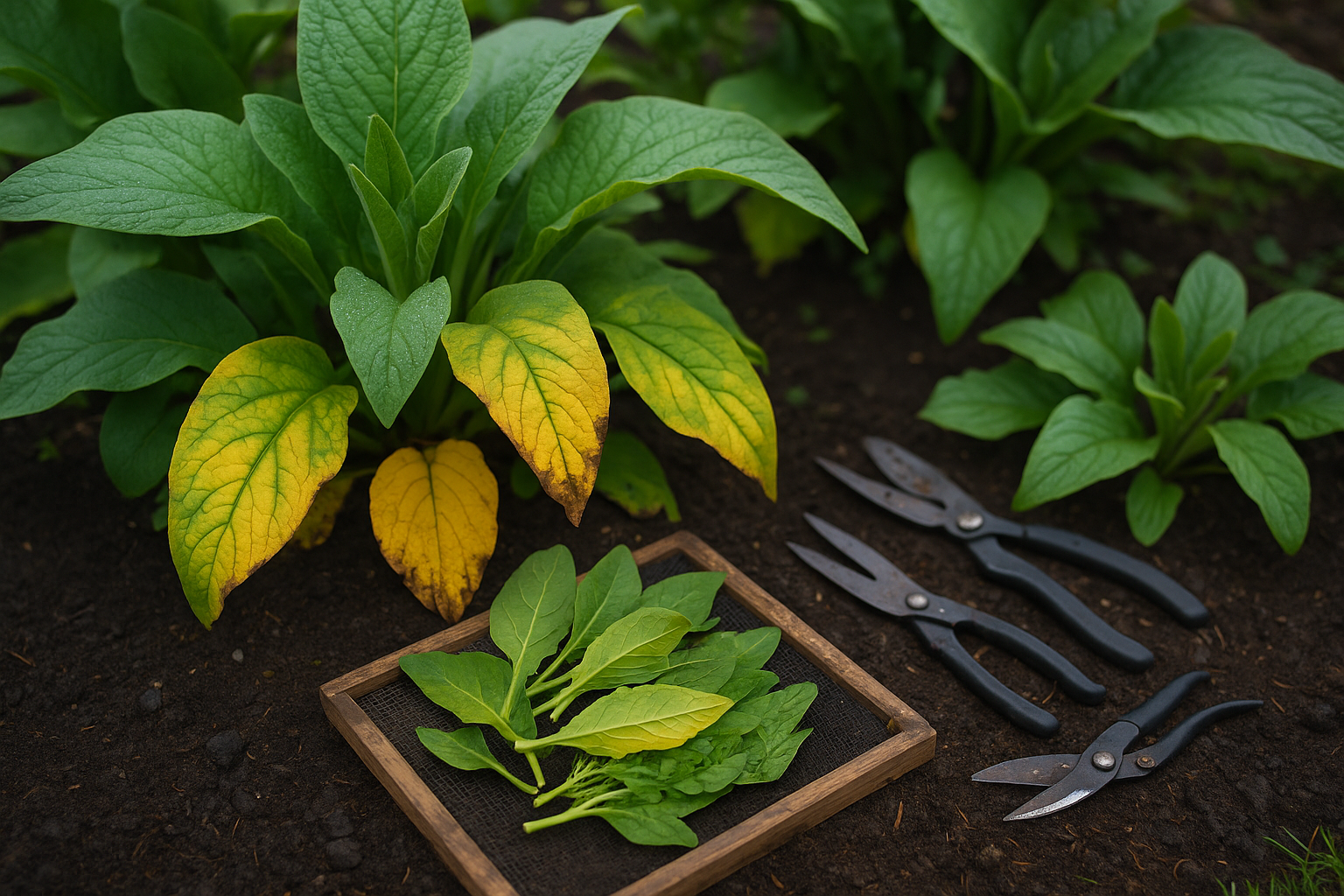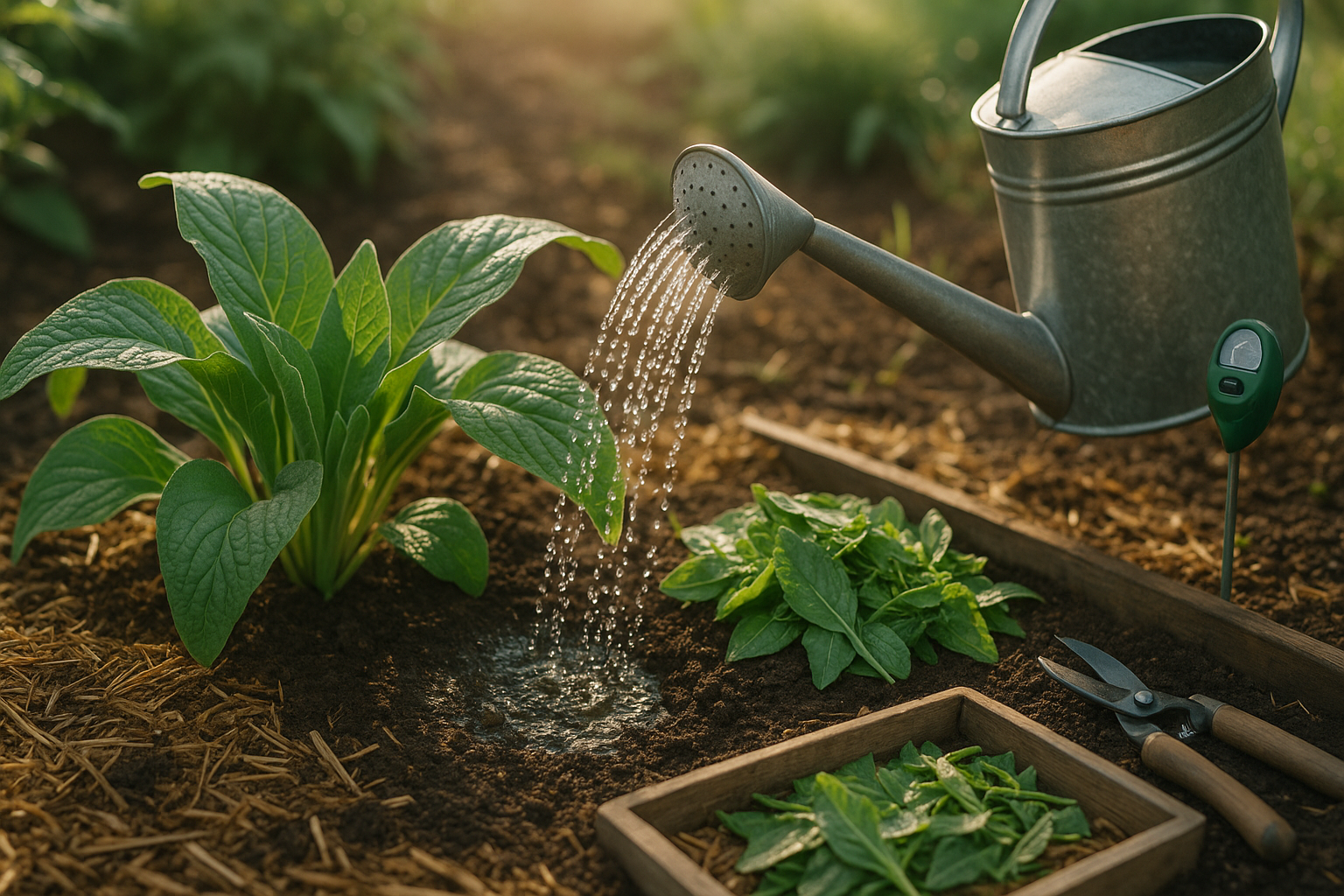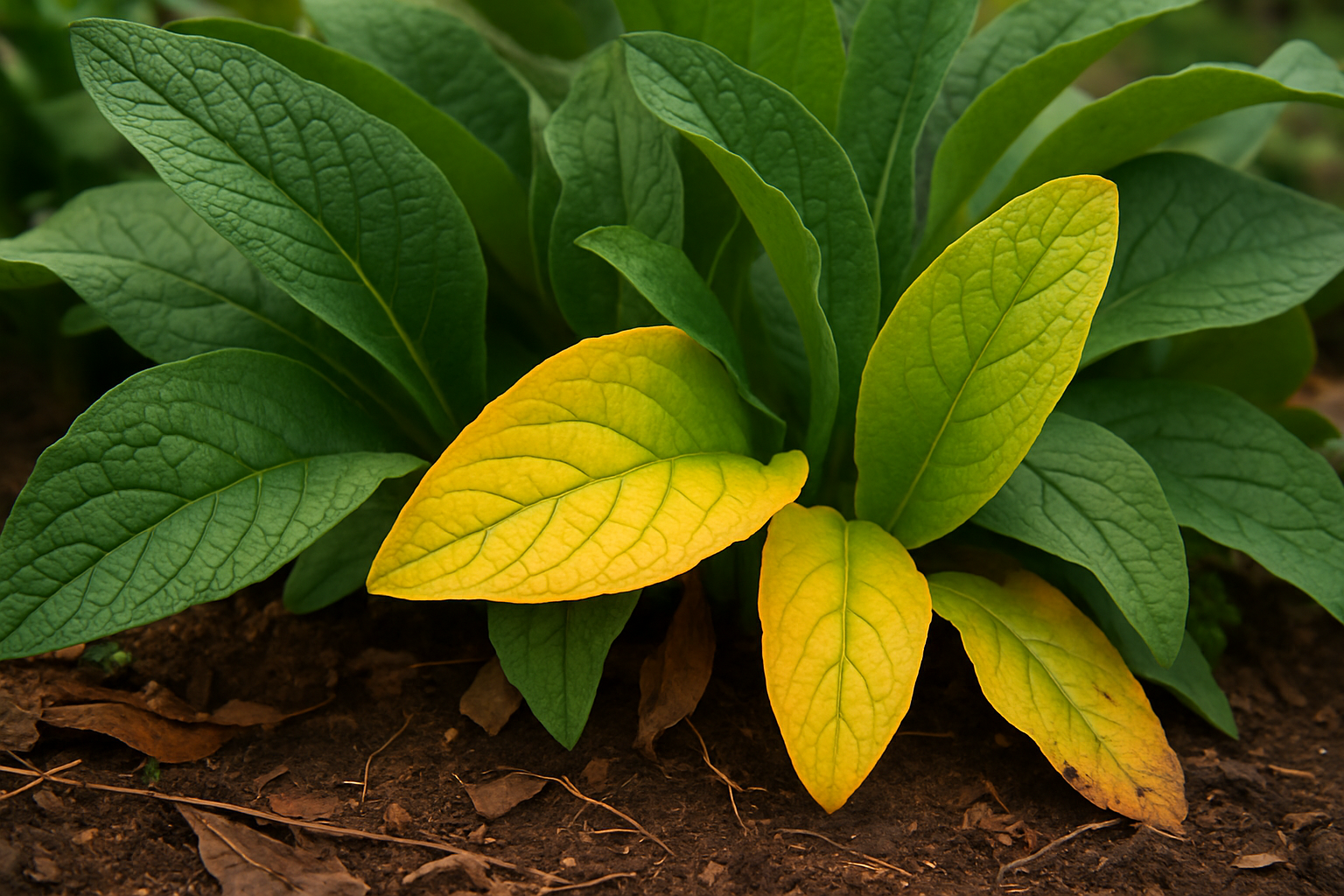Understanding Yellow Comfrey Leaves

Comfrey is a hardy perennial herb with lush, deep green leaves and clusters of bell-shaped purple or blue flowers. It’s often grown by gardeners for its usefulness as a natural fertilizer and soil conditioner. But if you notice comfrey leaves starting to yellow, it’s a clear sign that something isn’t right.
For gardeners, yellow leaves are concerning because they often indicate underlying issues that can impact the plant’s health and, by extension, the productivity of the garden bed. Common symptoms include mottled yellow spotting, complete yellowing of older leaves, and sometimes wilting or browning, crispy leaf edges. These visual cues can signal problems like nutrient deficiencies, overwatering, poor drainage, pest infestations, or even fungal diseases.
Simple signs—like yellow patches along the veins or leaves that droop suspiciously—warrant closer inspection. Early diagnosis is crucial: catching the problem quickly can make a big difference, allowing you to address the root cause before it spreads to other plants or affects the comfrey’s robust growth. For example, if yellowing is due to waterlogged soil, improving drainage can restore your plants before the roots suffer lasting damage.
Taking a proactive approach ensures your comfrey stays healthy, vibrant, and continues providing those beneficial nutrients for your garden.
Watering Woes

Comfrey is a hardy herb that thrives when given the right balance of moisture—neither too soggy nor bone dry. Generally, comfrey prefers consistently moist but well-drained soil, especially during the active growing season in spring and early summer.
Underwatering is easy to spot: you’ll notice limp, wilted leaves, browning around the edges, and slowed growth. On the other hand, overwatering leads to yellowing leaves, root rot, and a soggy smell from the soil.
Many gardeners make the mistake of watering on a fixed schedule rather than responding to the plant’s actual needs. A simple way to check soil moisture is to push your finger about two inches into the soil; if it feels dry at that depth, it’s time to water. Alternatively, use a moisture meter for more precision.
Always water at the base rather than overhead, and early in the day to allow excess moisture to evaporate. Mulching around comfrey helps retain moisture and regulate soil temperature, but avoid piling mulch right against the stems to prevent rot.
If you’ve been overwatering, let the top layers dry out before the next watering and consider improving drainage with compost or sand. For chronic underwatering, set reminders to check soil, mulch well, and position your plant where evaporation isn’t too rapid.
Remember, it’s better for comfrey to dry slightly between waterings than to sit constantly wet—strike that balance and your plants will reward you with lush, vigorous growth.
Soil & Root Health
Healthy, vibrant leaves start with strong roots and the right kind of soil—think of the soil as a plant’s foundation. Well-draining, fertile soil provides roots with the oxygen and nutrients they need to thrive, helping prevent common problems like yellowing leaves.
Much like overwatering can suffocate roots, compacted or poorly draining soil acts like a straitjacket, trapping water and leading to soggy conditions. In these situations, roots can’t breathe and often fall victim to root rot—an unseen enemy that quickly turns leaves yellow and limp. Common culprits include dense garden soil or old potting mix that’s broken down over time.
Regularly checking how quickly water drains from your pots or beds is an easy first step. If water pools on top or takes longer than a few seconds to seep in, your soil may need improving.
For potted plants, use a high-quality potting mix with added perlite or pumice to boost aeration. In gardens, loosen compacted areas with a fork or broadfork and amend soil with compost or organic matter to introduce air pockets and nutrients.
Repotting is wise if roots are circling the container or growing through drainage holes—signs they’re desperate for space. For stubbornly dense indoor pots, gently poke holes with a skewer or chopstick to improve airflow.
Remember, roots hidden from view need just as much care as leaves above. Focusing on soil and root health first creates resilient plants—and lush, green foliage is your reward.
Nutrient Deficiencies
Comfrey’s lush, fast-growing leaves are a sign of good nutrition, so keeping your plant supplied with the right nutrients is crucial for healthy growth. The main nutrients comfrey needs are nitrogen for leafy vigor, potassium for strong root and flower development, and magnesium for a lush green color.
When comfrey suffers from nitrogen deficiency, its lower leaves may turn pale green to yellow, while potassium shortages often show as yellowing or browning along leaf edges. Magnesium is especially important—if it’s lacking, you’ll notice yellowing between veins while the veins themselves remain green. If you see any of these yellowing patterns, it’s time to rethink your fertilizer routine.
Organic gardeners can feed comfrey with:
- Well-rotted manure
- Chicken pellets
- Comfrey tea (made by steeping mature comfrey leaves in water for a few weeks)
All of these are excellent for providing balanced nutrition. Adding wood ash to the soil boosts potassium, while a handful of Epsom salts around the base of the plants supplies magnesium when needed.
If you prefer synthetic options, a balanced all-purpose fertilizer (such as 10-10-10) works well—just follow package directions and avoid over-fertilizing, as comfrey is sensitive to excess nutrients.
Regularly top-dressing with compost in spring and midsummer helps keep plants thriving naturally. By watching your plants and feeding them thoughtfully, you’ll ensure a strong, productive comfrey patch that rebounds quickly after multiple cuts and keeps providing valuable biomass for your garden.
Pests & Disease
Yellowing leaves can indicate more than just water or sunlight problems—often, sap-sucking pests like aphids, spider mites, or whiteflies are to blame. Check closely for tiny green or brown bugs gathered on stems and the undersides of leaves (aphids), or look for fine, silvery webs that signal a spider mite attack. Slugs and snails are another common culprit, and you’ll usually spot their slimy trails or ragged holes in leaves.
Besides pests, fungal diseases are a major threat and can be easy to spot if you know what to look for: powdery mildew appears as a white, flour-like dusting, while leaf spot fungi cause small, dark, or yellow-edged splotches. Black sooty mold often coats leaves in a charcoal film, especially if sap-sucking pests are present.
To keep your plants healthy, start with prevention:
- Ensure good air circulation by spacing plants properly.
- Avoid watering late in the day when foliage stays damp overnight.
If pests appear, wash them off with a strong water spray or use insecticidal soap for heavier infestations. For slug problems, remove them by hand at dusk or use beer traps. If you catch a fungal disease early, trim off the affected leaves and use a safe fungicide or try homemade solutions like a baking soda spray.
Always remove fallen leaves and debris, which can harbor pests and pathogens, and remember: prompt action can save your plant before yellow leaves spread further.
Environmental Stress
Comfrey is a hardy plant, but it isn’t immune to environmental stress—especially when faced with low light, harsh sun, wild temperature swings, or strong winds. In shady spots, comfrey’s growth may slow, and leaves can become pale, so choose a garden area with partial to full sun for robust plants.
Too much intense sunlight, especially in the heat of summer, can scorch leaves, causing brown tips and wilting. Using mulch around the base helps retain soil moisture and cool the roots, while temporary shade cloths offer relief during heatwaves.
Sharp temperature drops, particularly late spring frosts, may damage new shoots. Keep frost blankets on hand or use upturned buckets overnight to shield delicate growth.
Windy conditions can tear comfrey’s large leaves or dry the plant out—positioning comfrey near a wall or fence can buffer sharp gusts.
For rapid stress fixes, water plants well during hot spells, and if hail or heavy winds strike, trim off any battered leaves to encourage healthy regrowth.
Keeping these simple protective strategies in mind ensures your comfrey bounces back quickly from most weather-related challenges, maintaining its lush vigor throughout the growing season.
Caring for Comfrey
To keep your comfrey healthy and prevent yellow leaves in the future, focus on a few simple but effective care habits. Water comfrey deeply once a week, especially during dry spells, but avoid waterlogging the roots, as soggy soil can cause yellowing.
Choose a planting spot with well-draining soil and enrich it with compost or aged manure each spring to boost nutrients and support healthy growth. Feeding isn’t usually necessary for comfrey, but if you notice yellowing, consider a light application of an organic fertilizer with balanced nitrogen.
Make it a habit to monitor your plants regularly—look for early signs of stress like drooping leaves or discoloration. Jot down any changes you notice in a notebook or on your phone, so you can track patterns and address issues before they worsen. Regular observation also helps you spot pests, fungal problems, or soil issues quickly.
Remember, comfrey is a tough and forgiving plant; with just a bit of attention, it generally bounces back from setbacks and rewards you with lush foliage and vibrant blooms. For gardeners who stay attentive, comfrey can become a lasting, low-maintenance asset—enriching your soil, attracting pollinators, and providing natural mulch for years to come.
